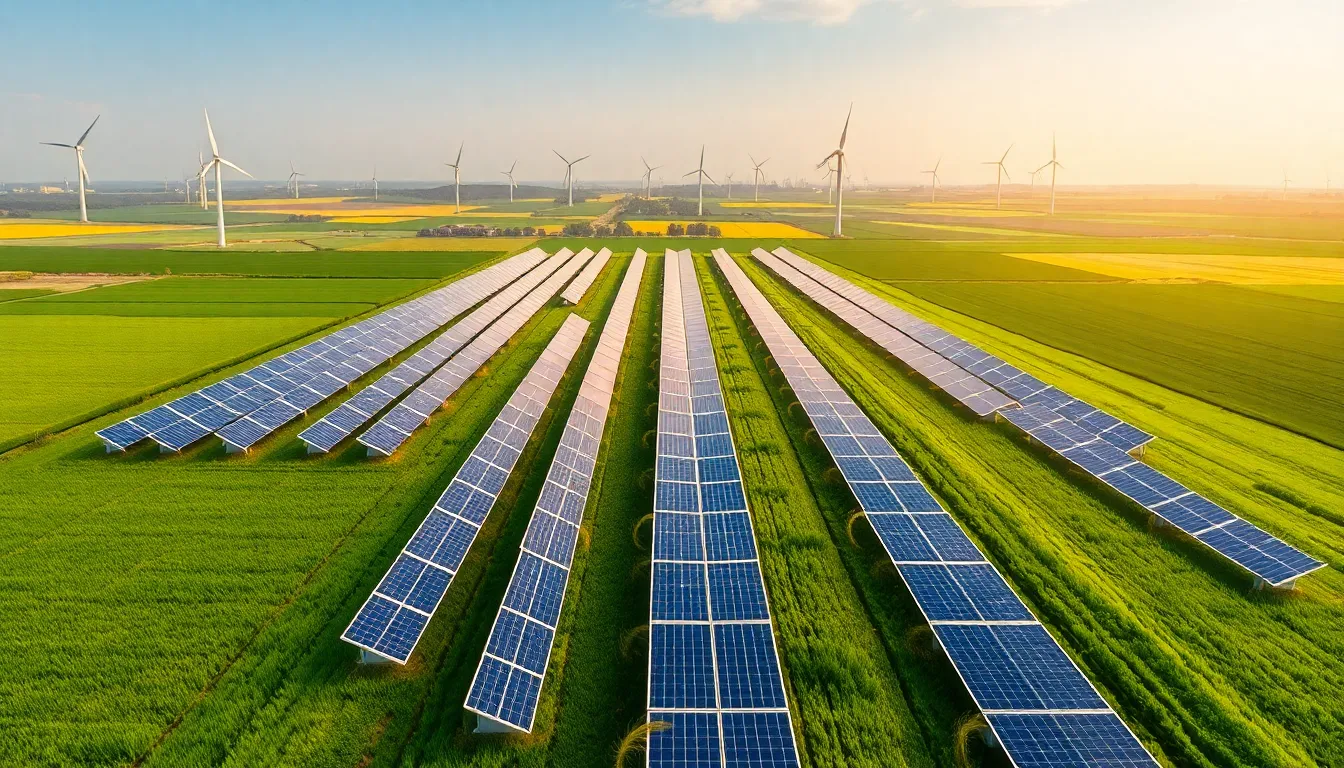Table of Contents
ToggleAs the world grapples with the pressing challenges of climate change, innovative solutions are emerging at an unprecedented pace. Climate tech, a burgeoning sector focused on technologies that mitigate environmental impact, is at the forefront of this transformation. From renewable energy sources to carbon capture systems, these advancements are reshaping industries and offering a glimmer of hope for a sustainable future.
Investors and entrepreneurs alike are recognizing the potential of climate tech to drive both economic growth and environmental stewardship. As more businesses adopt eco-friendly practices, the demand for cutting-edge technologies continues to rise. This article delves into the latest trends and breakthroughs in climate tech, highlighting how they’re not just addressing climate issues but also paving the way for a greener economy.
Overview of Climate Tech
Climate tech encompasses a wide array of technologies designed to combat climate change and minimize ecological footprints. This sector includes innovative solutions like renewable energy, energy storage, carbon capture and storage, and electric vehicles. Each technology addresses specific environmental challenges while contributing to sustainable practices.
Renewable Energy
Renewable energy technologies harness natural resources to generate power. Examples include solar panels, wind turbines, biomass energy systems, and hydroelectric power plants. According to the International Renewable Energy Agency, global renewable energy capacity reached approximately 2,800 gigawatts in 2020, marking a 10% increase from the previous year.
Carbon Capture Systems
Carbon capture and storage (CCS) technologies capture carbon dioxide from industrial processes and store it underground. CCS plays a significant role in reducing greenhouse gas emissions. Research shows CCS can reduce emissions from the industrial sector by up to 90% when implemented effectively.
Energy Storage Solutions
Energy storage solutions allow for the efficient utilization of renewable energy. Technologies, such as lithium-ion batteries and pumped hydro storage, store energy generated during peak production times for later use. The global energy storage market was valued at $7.06 billion in 2020 and is expected to reach $23.12 billion by 2027, reflecting its growing importance in the energy landscape.
Electric Vehicles
Electric vehicles (EVs) contribute significantly to reducing greenhouse gas emissions from the transportation sector. EV sales grew by 43% in 2020, with over 3 million units sold globally. This shift toward electrification helps meet stringent emission targets set by governments worldwide.
Climate Resilience Technologies
Climate resilience technologies focus on adapting to climate impacts. These solutions include flood management systems, drought-resistant agricultural practices, and sustainable urban planning. They improve infrastructure and community preparedness against climate-related disasters.
Overall, climate tech represents a vital component of global efforts to mitigate climate change. Its advancements pave the way for sustainable development, economic growth, and enhanced environmental stewardship.
Key Innovations in Climate Tech

Innovations in climate tech focus on creating solutions that mitigate environmental impact and promote sustainability. Here are some significant advancements in renewable energy and carbon capture technologies.
Renewable Energy Solutions
Renewable energy solutions harness natural resources and contribute significantly to reducing carbon emissions. Solar power reached approximately 1,100 gigawatts of capacity globally by 2020, demonstrating its substantial growth. Wind energy also expanded, achieving around 743 gigawatts of installed capacity. Geothermal and hydroelectric systems add diverse options for sustainable energy generation. Enhanced energy efficiency measures and the integration of smart grid technologies further optimize energy distribution and usage.
Carbon Capture Technologies
Carbon capture technologies play a critical role in reducing greenhouse gas emissions from industrial processes. Direct air capture systems can remove CO2 from the atmosphere, capturing approximately 1,000 metric tons of CO2 per installed unit annually. Carbon capture and storage (CCS) can reduce emissions from powered plants by up to 90%, making it a vital component in achieving climate targets. Emerging innovations in mineralization methods transform captured CO2 into stable minerals, permanently storing it underground. These advancements strengthen efforts to limit global warming by targeting emissions directly at their source.
The Role of Startups in Climate Tech
Startups play a critical role in climate tech, driving innovation and developing solutions that directly address climate challenges. Their agility and fresh perspectives foster a dynamic environment for technological advancement and sustainable practices.
Funding and Investment Trends
Funding for climate tech startups has surged in recent years, reflecting growing recognition among investors of the sector’s potential. In 2021, global investment reached approximately $60 billion, with venture capital firms increasingly targeting the climate space. Early-stage funding is crucial, as it supports the development of innovative technologies. Seed rounds often range from $500,000 to $5 million, enabling startups to build prototypes and validate their solutions. Notable investors include prominent venture capital firms such as Breakthrough Energy Ventures and Energy Impact Partners, fostering a diverse range of innovative projects.
Success Stories
Numerous startups have emerged as leaders in climate tech, showcasing the sector’s potential. Companies like NextEra Energy focus on renewable energy generation, utilizing solar and wind power to produce clean electricity. Another example is Climeworks, specializing in direct air capture technology that removes CO2 from the atmosphere, capable of capturing over 4,000 metric tons annually. Additionally, Rivian has disrupted the automotive industry with electric vehicles, achieving a 70% increase in demand since its inception. These examples underscore how startups effectively address climate change while driving economic growth and technological advancement.
Challenges Facing Climate Tech
Climate tech faces several challenges that hinder its rapid development and implementation. Addressing regulatory hurdles and market adoption issues proves crucial for advancing these technologies effectively.
Regulatory Hurdles
Regulatory hurdles create significant barriers for climate tech advancements. Governments often lack cohesive policies that support innovation. Inconsistent regulations across regions complicate compliance for startups and established companies. For instance, emissions standards may vary by state, leading to confusion in implementation. Strict approval processes can delay the deployment of new technologies, particularly in energy generation and carbon capture sectors. Navigating environmental assessments and obtaining necessary permits can extend timelines, discouraging investment. Alignment between national and local regulations enhances clarity, supporting smoother market entry for climate technologies.
Market Adoption Issues
Market adoption issues pose further challenges for climate tech. Consumer awareness and acceptance of new technologies influence their integration into everyday use. High initial costs of advanced solutions, like electric vehicles and energy storage systems, limit accessibility for many consumers. For example, despite the growing availability of electric vehicles, price points remain a barrier for widespread adoption. Industry players must demonstrate the long-term cost benefits and environmental advantages to increase market penetration. Additionally, traditional industries may resist transitioning to more sustainable practices due to established habits and infrastructure. Effective marketing strategies and evidence-based success stories are necessary to encourage consumers and industries to embrace climate tech solutions.
Future Directions in Climate Tech
Innovations in climate tech are poised to play a critical role in addressing the multifaceted challenges of climate change. Key areas of focus include enhanced energy efficiency, advanced materials, and sustainable agriculture technologies.
Enhanced Energy Efficiency
Enhanced energy efficiency technologies significantly reduce energy consumption. Solutions such as smart grids use AI and IoT to optimize energy distribution. This can result in energy savings exceeding 20% in some regions. Building retrofits can improve energy performance by 30% or more, lowering emissions while reducing operational costs.
Advanced Materials
Advanced materials hold promise for carbon capture and renewable energy. Developments in materials science lead to more efficient solar panels and wind turbines. For example, perovskite solar cells have the potential to boost efficiency rates beyond traditional silicon cells, with efficiencies over 25% demonstrated in laboratories. Similarly, lightweight and durable materials can improve the performance of electric vehicles, contributing to emission reductions.
Sustainable Agriculture
Sustainable agriculture technologies are transforming farming practices. Precision agriculture integrates data analytics and IoT to optimize crop yields, potentially increasing productivity by 20% while reducing resource waste. Innovative soil management techniques enhance carbon sequestration, with practices such as cover cropping and reduced tillage improving soil health and capturing atmospheric CO2.
Circular Economy Practices
Circular economy practices are gaining traction in climate tech. These strategies focus on minimizing waste and maximizing resource use, facilitating recycling and reusability. Companies adopting circular economy principles can cut resource costs by 30% while minimizing environmental impact. Examples include fashion brands utilizing recycled materials and focusing on sustainable manufacturing processes.
Education and Awareness
Education and awareness efforts enhance public understanding of climate issues. Expanding outreach initiatives can increase participation in sustainability programs by 40%. Educational platforms that promote climate literacy enable individuals and companies to make informed choices about adopting climate-friendly technologies.
Collaborative Efforts
Collaborative efforts among governments, businesses, and NGOs can amplify climate tech initiatives. Public-private partnerships create funding opportunities and streamline resource sharing. Collaborative projects, such as smart city developments, showcase the potential of integrated climate solutions for urban sustainability.
Future advancements in climate tech rely on the commitment to innovation, sustainability, and inclusivity. By investing in multifaceted solutions, stakeholders can drive progress toward a sustainable future.
The climate tech sector is poised for transformative growth as it addresses pressing environmental challenges. With innovative solutions emerging and significant investments flowing into startups, the potential for economic growth alongside sustainability is clearer than ever.
However, navigating regulatory hurdles and market adoption remains critical for success. As awareness and education around climate technologies increase, collaboration among stakeholders will be vital for driving impactful change.
The future of climate tech holds promise, paving the way for a more sustainable world where technology and environmental stewardship go hand in hand.







